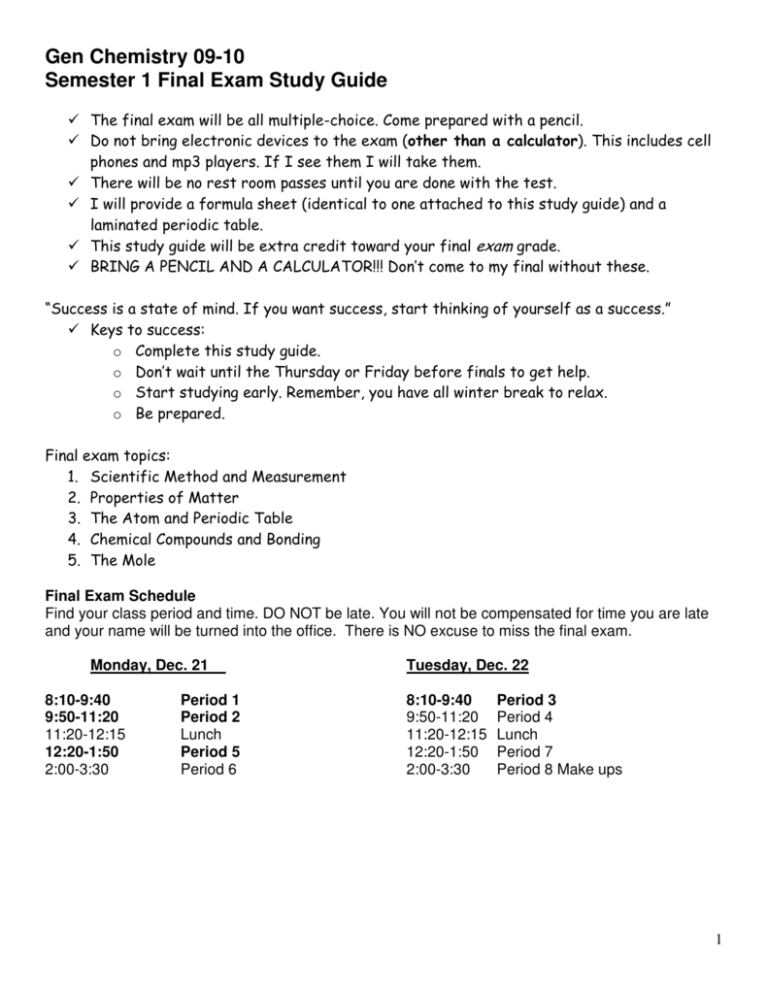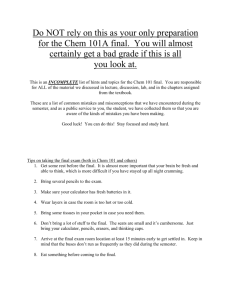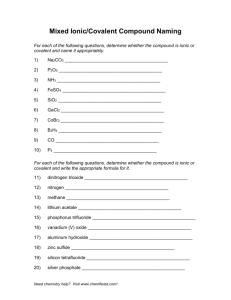Gen Chemistry 09-10 Semester 1 Final Exam Study Guide
advertisement

Gen Chemistry 09-10 Semester 1 Final Exam Study Guide ! " # $ % & '( $ ) &$ & & ) * )& + # ,,, ./ 0 2 4 # 3 6 / ' & 8 9 ! 1 3 o o o / o " 5 7 - 4 0 ! 6 6 ' " 6 Final Exam Schedule Find your class period and time. DO NOT be late. You will not be compensated for time you are late and your name will be turned into the office. There is NO excuse to miss the final exam. Monday, Dec. 21 8:10-9:40 9:50-11:20 11:20-12:15 12:20-1:50 2:00-3:30 Period 1 Period 2 Lunch Period 5 Period 6 Tuesday, Dec. 22 8:10-9:40 9:50-11:20 11:20-12:15 12:20-1:50 2:00-3:30 Period 3 Period 4 Lunch Period 7 Period 8 Make ups 1 Classify the following as either a hypothesis or observation. 1) A blue flame will heat water faster than an orange flame. 2) The skittle is red. 3) Adding fertilizer to water will help the tree grow better than just using water alone. 4) The reaction gave off gas. 5) The color of the liquid is bright blue. Convert the following values to the given unit. 6) 76.3 kg = ___________ g 7) 579 L = ____________ mL 8) 1289.6 km = ________ m 9) 43 m = ____________ mm 10) 38.4321 HL= _______ L 11) How do you determine the density of an object from a volume and mass? 12) How do you determine the volume of an object from a density and mass? 13) How do you determine the mass of an object from a volume and density? 14) Define compound. 15) Define element 16) Define heterogeneous mixture 17) Define homogeneous mixture. Classify the following as one of the above choices from 14-17. 18) Potassium sulfide, K2S 19) Fruit salad 20) Gasoline 21) Oxygen 22) Sand mixed with iron filings 2 23) For each of the following scientists, explain the information they discovered, and why they are important. Scientist John Dalton Information they discovered Why are they important? JJ Thomson Ernst Rutherford Neils Bohr Erwin Schroedinger 24) What are valence electrons and why are they so important? 25) Location Proton Neutron Electron Charge Mass 26) Draw the lewis dot structure for the each of the following elements: a. Helium d. Sulfur b. Sodium e. carbon 3 27) Directions: Label the following on the Periodic Table Below Metals Non-Metals Rare Earth Metals Halogens Alkaline Earth Metals Noble Gases Transition Metals Metalloids Alkali Metals Most reactive metal Group with 5 valence electrons Charges on group A elements 4 Gen Chem 09-10 Sem 1 Review 27) What is an ion? 28) What is an isotope? 29) What is a group on the periodic table? 30) A period? 31) For each of the following trends, you must be able to explain what happens as you move down a group, across a period, and why. Atomic Radius As you move down a group Why? As you move across a period Why? Ionization Energy Atomic Mass ReactivityNonmetals ReactivityMetals 32)An ionic bond is formed when… A A metal and a nonmetal share electrons. B A metal takes the electrons away from a nonmetal. C Two nonmetals share electrons. D A nonmetal takes electron away from a metal. 5 Gen Chem 09-10 Sem 1 Review 33) A covalent bond is formed when… A Two nonmetals share electrons B A metal and a nonmetal share electrons. C A metal takes the electrons away from a nonmetal. D A nonmetal takes electrons away from a metal. 34) A polyatomic ion is when… A The same as a covalent compound. B An element with a charge. C When two or more atoms are neutral. D When two or more bonded elements have a collective charge. 35) Use these choices to answer the following questions. Each choice can be used more than once. Each question has only one answer. A B C Acid Ionic Covalent a) CCl4 b) Hg(OH)2 c) Rb2SO3 d) Radon Difluoride e) Carbonic Acid f) Tungsten (I) Sulfite g) HNO3 h) Cobalt (IV) Arsenate 6 Gen Chem 09-10 Sem 1 Review IONIC COMPOUND NOMENCLATURE Define binary compound and describe how to name them. Ex) sodium chloride, Lithium bromide, Magnesium bromide, Calcium chloride Describe how to name a compound containing a polyatomic ion. Describe how to write the formula for a binary ionic compound. Ex) NaCl, LiBr, MgBr2, CaCl2 Transition elements can have more than one charge. How do you name ionic compounds that contain transition elements? Ex) Potassium cyanide, Sodium Ex) Iron (III) bicarbonate, Iron (II) hydroxide, Sodium nitrate, Ammonium chloride, Manganese (IV) oxide chloride, Calcium phosphate Describe how to write the formula of an ionic compound containing polyatomic ions. Ex) KCN, NaOH, NaNO3, NH4Cl, Ca3(PO4)2 How do you write the formula for ionic compounds that contain transition elements? Ex) Fe(HCO3)3, FeCl2, MnO2 7 Gen Chem 09-10 Sem 1 Review COVALENT COMPOUND NOMENCLATURE Complete the following graphic organizer by filling in each square with information that best explains the statement in each box. What are physical and chemical properties of covalent compounds? Define diatomic molecule, list the names of all 7, and list their formula When naming covalent compounds, what rules should you follow? Ex) Nitrogen dioxide Dinitrogen monoxide When writing the formula for covalent compounds, what rules should you follow? Ex) NO2 N2O 8 Gen Chem 09-10 Sem 1 Review Given the name, identify each of the following as Ionic (I), covalent (C), or acid (A). Then, write the formula. _____ 35. sulfuric acid __________________________________________ _____ 36. sodium hydroxide __________________________________________ _____ 37. sodium bromide __________________________________________ _____ 38. barium hydroxide __________________________________________ _____ 39. manganese (IV) oxide __________________________________________ _____ 40. sulfur dioxide __________________________________________ _____ 41. iron (II) sulfide __________________________________________ _____ 42. hydrochloric acid __________________________________________ _____ 43. potassium permanganate__________________________________________ _____ 44. sulfur trioxide __________________________________________ _____ 46 copper (II) hydroxide __________________________________________ _____ 47. ammonium sulfide __________________________________________ _____ 48. nickel (II) bromide __________________________________________ _____ 49. iron (II) oxide __________________________________________ _____ 50. acetic acid __________________________________________ Given the formula, identify each of the following as Ionic (I), covalent (C), or acid (A). Then, write the name. _____ 51. CaCO3 ________________________________________________ _____ 52. FeO ________________________________________________ _____ 53. H2CO3 ________________________________________________ _____ 54. AgCl ________________________________________________ _____ 55. N2O ________________________________________________ _____ 56. Ba(OH)2 ________________________________________________ _____ 57. Na2S ________________________________________________ 9 Gen Chem 09-10 Sem 1 Review _____ 58. KrCl2 ________________________________________________ _____ 59. H3PO4 ________________________________________________ _____ 60. (NH4)2SO4 ________________________________________________ _____ 61. HC2H3O2 ________________________________________________ _____ 62. Zn(NO2)2 ________________________________________________ _____ 63. CuSO4 ________________________________________________ _____ 64. XeF4 ________________________________________________ _____ 65. NaOH ________________________________________________ The Mole 66) How big is a mole? It’s the same as Avogadro’s number. 67) How do you convert from molecules to moles? 68) How do you convert from atoms to moles? 69) How do you convert from atoms or molecules to grams? Draw one graphic organizer than summarizes how to convert from particles to moles and from moles to grams. 70) How many moles are in 3.54x1024 atoms of Cu? 71) How many molecules are in 8.7 moles of Ne? 10 Gen Chem 09-10 Sem 1 Review 72) How many moles of S8 are in 12.3x1025 molecules of S8? 73) How many moles are there in 150 grams of Al(OH)3? 74) How many moles are there in 68 grams of CuSO4? 75) How many grams are there in 4.4 moles of Fe2(SO4)3? 76) A 200 mg tablet of vitamin C is how many ounces? (this is the recommended daily allowance of vitamin C) 77) A car traveling 70 mph has a speed of how many meters per second? 78) Find the mass in grains of a .800 g aspirin tablet. (Given: 1000 milligrams = 15.4 grains). 11 Gen Chem 09-10 Sem 1 Review 79) For the ice cream lab we need to use cream. Find the number of cups of cream in 2.5 gallons. (Given: 1 pint= 2 cups). 90) Calculate the number of hours in 29 years, 1 month, and 4 days. (The number of hours I will be old on your first day of holiday break) 82) Use the graph to answer the next questions. D E C B A Which letter(s) represent a phase change? Which letter(s) represent states of matter? Which letter(s) represent a change in kinetic energy? Which letter(s) represent a change in potential energy? When are the molecules changing speed? 12 Gen Chem 09-10 Sem 1 Review 83) Define the following words: a. Group (on the periodic table) f. Atomic radius b. Period (on the periodic table) g. atom c. Ionization Energy h. Atomic number d. Reactivity i. Periodic e. Malleable Note: The following will be given to you on the final exam, but on a separate sheet. Conversion Factors 1 in = 2.540 cm 1 m =1.0936 yd 5280 ft = 1 mi 1 mi = 1.6093 km 3 ft = 1 yd 12 in = 1 ft 1 lb = 454 g 16 oz = 1 lb 1 kg = 2.205 lb 1 calorie = 4.184 Joule 1.0567 qt = 1 L 1 fluid oz = 30 ml 2 cups = 1 pint 2 pint = 1 qt 4 qt = 1 gal 1 gal = 3.7854 L 1 gal = 3785 cm3 1 tsp = 5 ml 3 tsp = 1 Tbs m = meter mi = mile ft = feet in = inch yd = yard lb = pound oz = ounce L = liter qt = quart tsp = teaspoon gal = gallon Tbs = tablespoon kilo – hecto – deka – BASE – deci – centi - milli MASS PARTICLES Molar Mass Avogadro’s Number MOLES Molar 13







